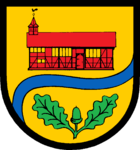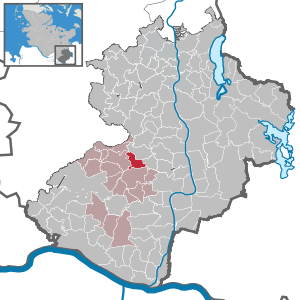Fuhlenhagen
| coat of arms | Germany map | |
|---|---|---|

|
Coordinates: 53 ° 34 ' N , 10 ° 32' E |
|
| Basic data | ||
| State : | Schleswig-Holstein | |
| Circle : | Duchy of Lauenburg | |
| Office : | Schwarzenbek country | |
| Height : | 46 m above sea level NHN | |
| Area : | 5.74 km 2 | |
| Residents: | 386 (Dec. 31, 2019) | |
| Population density : | 67 inhabitants per km 2 | |
| Postal code : | 21493 | |
| Area code : | 04156 | |
| License plate : | RZ | |
| Community key : | 01 0 53 031 | |
| LOCODE : | DE 56Y | |
| Office administration address: | Gülzower Strasse 1 21493 Schwarzenbek |
|
| Website : | ||
| Mayor : | Wolfgang Krüger (FWF) | |
| Location of the municipality of Fuhlenhagen in the Duchy of Lauenburg district | ||
Fuhlenhagen is a municipality in the Duchy of Lauenburg district in Schleswig-Holstein . Apart from Fuhlenhagen, the municipality has no other districts.
geography
The place is about 11 km north of Schwarzenbek.
history
Fuhlenhagen was mentioned for the first time in 1261 as "Herbeckhagen". The origin of the name Fuhlenhagen is not clear. The original name "Herbeckhagen" either stands for the "enclosed clearing of Heribercht or Herbert", which was later reinterpreted as Fuhlenhagen, or Fuhlenhagen is made up of "ful" (lazy) and "Hagen" (cleared forest).
Finds of stone hatchets and battle axes from the Neolithic Age attest to the settlement of today's municipal area by a rural population in the Early Stone Age. The discovery of an Iron Age spindle whorl from the Roman Empire makes a longer settlement tradition at this place seem at least possible.
Fuhlenhagen is a Waldhufendorf (colonized by clearing - the houses form a long chain of individual farms along a street). Fuhlenhagen is mentioned in the tithe register in 1239, but then belonged to Reinbek monastery with seven other villages . Then it was pledged to the Counts of Oldenburg, recognizable by the coat of arms in the windows of the chapel (1622). The Knicks are not natural but cultural monuments. They were created by the peasants at the behest of the nobility. This prohibited the farmers from using the forest.
Fuhlenhagen was at no time serf, but manual and clamping services had to be done to the nobility in the neighborhood. In 1513 Fuhlenhagen had nine full-time workers. From 1600 onwards there were eight full-heapers and one half-heap and five Käthner.
politics
Community representation
Of the nine seats in the municipal council, the constituencies AWF and FWF each have four seats and the constituency UWF one seat since the 2013 local elections.
coat of arms
Blazon : "A slightly lowered blue wavy bar in gold, above a red chapel with 16 golden windows, below a green oak branch with two fan-shaped leaves that enclose an acorn."
Attractions
The list of cultural monuments in Fuhlenhagen includes the cultural monuments entered in the list of monuments of Schleswig-Holstein.
Transmission mast
The Mölln transmitter is located in the district of Fuhlenhagen .
Chapel of St. George
The listed half-timbered chapel St. Georg is one of the oldest half-timbered chapels in northern Germany. The external dimensions are: 13.25 meters long and 6.00 meters wide. Overhanging east gable wall in the altar wall, bell tower over the western part of the building, entrance door in the south wall. According to a dendrodating carried out in 2009, the oldest half-timbered beams date from around 1580 (eastern part of the building). Several lead-glazed coat of arms windows in the east wall bear the year 1622.
In front of the current building there was a previous chapel in the same place, which was also consecrated to St. Georg (St. Jürgen) and from which some furnishings are still available. A small Gothic bell in the wood-clapboard chapel tower, which has been rang by hand to this day, is dated to around 1280. In terms of shape and sound, it is a monastery chapel bell. A carved oak relief “St. Georg fights with the dragon ”is dated in its main inventory (St. George's figure on the horse and dragon's body) in the 14th or 15th century, in his restored additions (dragon head, horse head, horse tail) later. A late Gothic carved colored altarpiece relief from the 14th or 15th century shows a mercy seat : God the Father on the heavenly throne holds the cross with his Son Jesus Christ on his lap in front of him. Between the face of God the Father and the crucifix one recognizes a dove, the Holy Spirit, at chest level. Another late Gothic crucifix comes from around the same time as the altarpiece relief. It originally hung on the altar lid, now it hangs on the north wall next to the pulpit.
Several renovations and maintenance works over the centuries have changed the original exterior and interior appearance of the chapel. The originally thatched chapel roof was covered with tiles a long time ago (the building was thus spared in a village fire in 1916). The old stalls were replaced by modern pews in 1964, the wooden altar by a brick altar, and a brick baptismal column with a brass bowl insert gave baptisms in the chapel a permanent liturgical place right next to the entrance door. In 1967 a small organ with four registers was installed in the gallery (without pedals, only with manual).
In the pre-Reformation period, the chapel belonged to the Reinbek monastery and was spiritually cared for by its branch in Köthel. Since the time of the Reformation, the chapel board has been Ev.-Luth. Kapellengemeinde Fuhlenhagen responsible for the chapel. Spiritual support is provided by the pastor of the neighboring ev.-luth. Parish of Sahms. On every first Sunday of the month, on special occasions and on Christian celebrations, services are held in the chapel.
Myths
Many people saw the Wode ( Odin ) in the "Twelfth" (the nights from Christmas to Epiphany) and especially on Christmas Eve. He rides a large white horse; a hunter on foot and twenty-four wild dogs follow him. Wherever he passes through, the fences collapse with a crash and the path is leveled before him; but towards morning the enclosures stand up again. Some people claim that his horse only has three legs. He always rides the same paths past the doors of the houses, and so fast that his dogs are not always able to follow him; you can hear them panting and howling. Sometimes one of them has broken down. One of Wode's dogs was once found in a yard in Wulfsdorf, another in Fuhlenhagen on the hearth where he had stretched out, constantly crying and puffing, until Wode took him back on the following Christmas Eve. You are not allowed to leave laundry hanging outside that night. The dogs would tear them apart. You shouldn't bake either. All residents must stay at home quietly. If you leave the doors open, the Wode pulls through, and his dogs eat everything that is edible in the house. Once the Wode had gotten into the house of a poor farmer, and the dogs had consumed it all. The poor man wailed and asked the Wode who would make good the damage that the dogs had done. Wode replied that he would pay for everything. Soon afterwards he appeared with a dead dog and ordered the farmer to throw the carcass into the chimney. The farmer did that, and the bellows burst, and nothing but shiny pieces of gold fell out. The Wode has a certain path that it rides every year in the "Twelfth". This leads around Krumesse over the moor to Beidendorf. When he comes, the subterranean have to flee, because he wants to destroy them from the earth. Once an old farmer left Beidendorf late and wanted to go to Krumesse, suddenly he noticed how the underground came running up. But they weren't afraid at all and shouted cheerfully: “He can't harm us today, he should just leave us alone; he hasn't washed himself this morning. "
When the farmer had wandered a little further, the Wode met him and asked him what the little ones had called. The farmer replied that they had said that he hadn't washed this morning and therefore couldn't do them any harm. Then the Wode stopped his horse, dismounted, and washed himself. Then he jumped back on his horse and chased after the underground. Not long afterwards the farmer saw the Wode coming back; he had tied the poor little ones by their long hair and had several of them hanging on each side of the horse. Wode pursued the underground so cruelly. Today they are all gone. Therefore the Wode no longer hunts on the earth, but up in the air. The Wode is still widely known in Schleswig-Holstein; therefore, many people close their doors on him at Christmas time.
Web links
Individual evidence
- ↑ North Statistics Office - Population of the municipalities in Schleswig-Holstein 4th quarter 2019 (XLSX file) (update based on the 2011 census) ( help on this ).
- ↑ Schleswig-Holstein topography. Vol. 3: Ellerbek - Groß Rönnau . 1st edition Flying-Kiwi-Verl. Junge, Flensburg 2003, ISBN 978-3-926055-73-6 , p. 176 ( dnb.de [accessed April 22, 2020]).
- ↑ Schleswig-Holstein's municipal coat of arms
- ^ Ludwig Bechstein: German book of legends. 1853, Georg Olms Verlag, Reprint 2003, ISBN 3-487-12501-3



